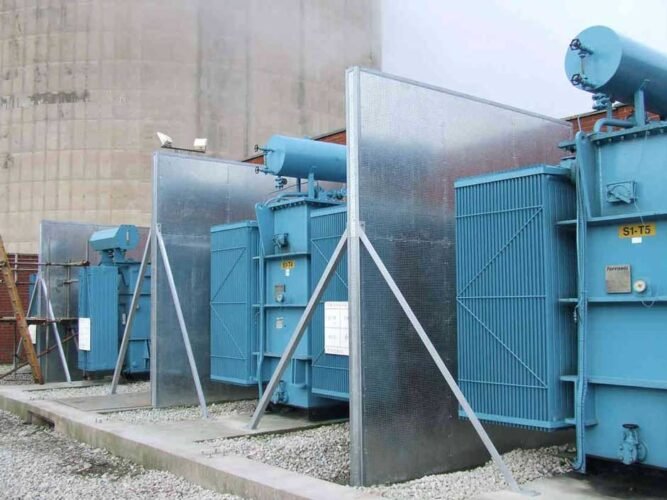Transformer blast walls play a critical role in modern industrial and commercial facilities by providing a layer of protection that mitigates the risks associated with transformer failures. Transformers, as essential components of electrical infrastructure, carry inherent dangers such as explosions or fires caused by internal faults or external impacts. These incidents can lead to extensive property damage, operational downtime, and even pose threats to human safety. Installing blast walls around transformers is a strategic measure that helps contain such events, reducing the liability risks faced by facility owners and operators. We will explore how transformer blast walls function to protect facilities and the key ways they contribute to minimizing potential liabilities.
How Transformer Blast Walls Help Mitigate Liability Risks
1.Containing Explosive Energy and Debris
One of the primary functions of the transformer wall is to contain the energy released during a transformer explosion. When a transformer fails catastrophically, it can eject high-pressure gases and flying debris at dangerous velocities. These forces not only risk damaging nearby equipment but also endanger personnel working in proximity. Transformer blast walls are engineered to absorb and deflect this explosive energy, significantly reducing the range and impact of flying debris. By physically containing these hazards, the walls help prevent the chain reaction of damage that could lead to escalating insurance claims and legal consequences. In addition to structural containment, these walls reduce the likelihood of collateral damage to adjacent infrastructure, safeguarding the overall integrity of the facility.
2.Limiting Fire Spread and Environmental Impact
Transformers typically contain large volumes of insulating oil, which, if ignited, can cause intense fires that spread rapidly. Without proper barriers, such fires can engulf nearby structures and equipment, magnifying the scale of destruction and complicating emergency response efforts. Transformer blast walls serve as fire-resistant barriers that compartmentalize the fire risk, isolating the transformer from other critical assets and equipment. This containment limits the potential for fire escalation and environmental contamination, including oil spills and the release of toxic smoke. From a liability perspective, the ability to curtail environmental damage and property loss is crucial in reducing regulatory penalties and costly remediation efforts. Moreover, facilities equipped with these walls demonstrate a proactive commitment to safety and compliance, which can positively influence risk assessments and insurance premiums.
3.Protecting Personnel and Enhancing Workplace Safety
Ensuring the safety of employees and contractors is a top priority for any facility. Transformer incidents can pose significant risks to individuals working nearby, ranging from blast injuries to exposure to hazardous substances. Transformer blast walls are strategically positioned to create a safety buffer zone, shielding personnel from the immediate effects of transformer failures. By minimizing the risk of injury, these barriers enable organizations to meet their occupational health and safety requirements, thereby reducing liability related to workplace accidents. Furthermore, the presence of blast walls supports emergency planning by defining safe zones and improving evacuation protocols. This focus on human safety not only protects individuals but also reduces the likelihood of costly workers’ compensation claims and legal disputes.
4.Facilitating Compliance with Industry Standards and Regulations
Facilities that incorporate transformer blast walls align with industry guidelines and regulatory standards designed to manage electrical and fire risks. Compliance with such standards is increasingly scrutinized by authorities having jurisdiction and insurance underwriters. Installing blast walls demonstrates that a facility has taken reasonable and effective measures to address transformer-related hazards, which can be a decisive factor in liability cases. Failure to implement adequate protective measures may result in fines, legal liability, or loss of coverage. Therefore, transformer blast walls contribute not only by physically mitigating risks but also by supporting regulatory adherence, which ultimately strengthens the facility’s legal and financial standing.
5.Reducing Downtime and Financial Exposure
Transformer incidents can cause significant operational disruptions, resulting in financial losses that far exceed immediate repair costs. Facility downtime disrupts production schedules, delays service delivery, and undermines customer confidence. By containing damage and limiting fire spread, blast walls help ensure that an incident involving one transformer does not cascade into a wider facility shutdown. This containment reduces the scope of repairs and accelerates recovery time. From a liability standpoint, mitigating downtime translates to decreased exposure to business interruption claims and contractual penalties. Moreover, it positions the facility to maintain steady revenue streams and reduces the overall financial impact of transformer-related incidents.
6.Enhancing Insurance Negotiations and Coverage Terms
Insurance companies evaluate risk mitigation efforts closely when determining policy terms and premiums for facilities housing high-voltage electrical equipment. Transformer blast walls are tangible evidence of a facility’s commitment to risk reduction, which can positively influence insurance negotiations. Facilities equipped with these barriers may benefit from more favorable coverage conditions, lower premiums, and quicker claim settlements in the event of an incident. Conversely, the absence of adequate protective measures can lead to higher costs and limited coverage. Therefore, investing in transformer blast walls is not only a safety consideration but also a strategic financial decision that helps manage liability through improved insurance arrangements.
Transformer blast walls are a vital component in mitigating risks associated with electrical transformers. By effectively containing explosive energy, limiting fire spread, protecting personnel, and supporting regulatory compliance, these barriers reduce the liability burden for facility owners and operators. Their role extends beyond immediate safety concerns to include minimizing downtime, influencing insurance terms, and safeguarding the facility’s reputation.
Implementing transformer blast walls represents a comprehensive approach to risk management that balances operational continuity with legal and financial responsibility. As facilities continue to evolve and face increasing safety demands, the strategic use of transformer blast walls will remain an important factor in reducing liability and promoting sustainable facility management.






